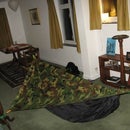Introduction: DIY Bike Panniers - Homemade Bicycle Panniers
Here is the complete set panniers I made for my touring bicycle. I simply expanded on existing ideas I found on Instructables and other sites concerning the fabrication of homemade panniers.
Step 1:
I had already started coating the bags. The material is a polyester canvas. I welded the seems together with a flat tipped soldering iron and put zig-zag stitches to add strength. I just cut a long piece of material and made a squared U out of it. I then used two rectangle pieces for the sides and good old velcro for the closures.
Step 2:
I was trying to make drysacks but I had no pattern. I ended up with a small breach in the sides when I roll it over.
Step 3:
So I made a hood to cover the entire top of the bag. Said breach has been addressed.
Step 4:
In playing with Plasti Dip in the past I had always wondered what it would be like if I covered material with it. I figured this was a perfect project to experiment using the stuff. It is very nasty but TOUGH stuff. I use the dip can like paint for the seams and the bottom. I coated the bottom and sides many times by simply painting it on with a brush. I then sprayed the entire bag with the spray version. I kept adding coats until I could not see daylight through it when held up to my work light. It takes about one can of each for the pair of panniers. Please be careful, even when working outside this stuff requires a mask. It is also quite flammable.
Step 5:
This is the backside of the front pannier. I used techniques I learned from this and other sites for the mounting mechanism. I discovered I had to change it a little when I purchased the JANDD racks. I was using the O ring method but the bottom of the Jandd racks are different than the ones I started with. Nothing to attach the O to. So I changed it to a system that hooks on to the bottom rod of the rack so tension is provided to keep the panniers from bouncing off. The hardware is from a bicycle car rack that was no longer useful. It is what I had lying around. To keep the shape nice and square I used coroplast (elections sign plastic cardboard) on the inside. It is an "L" shape the width of the bag and the length of the back and bottom. I also used two pieces of aluminum 1/8" strap as a large washer. One that spans across the top between the hooks and a smaller one that spans the hooks. I did this so it would not pull through the coroplast and to help retain shape during load. I purchased the bungies from a typical big box home improvement center. I had the bolts laying around. I also put plumbers tape (teflon) around the bolts which keeps them from unscrewing.
Step 6:
Here are the completed front bags.
Step 7:
the rear panniers I used a pair of matching backpacks I found at an SPCA restore. Even more cool was the material they were made from which was 100% recycled water bottles! I cut the straps off to minimize the bags but I kind of wish I had left them on so I could more easily carry these things when dismounted. I left the handle on top which works when carrying them off the bike and also helps to secure smaller rolled items when used in conjunction with velcro strapping. I used the same technique of brushing on the bottom and edges and then spraying the entire bag. I even sprayed over the zippers. I kept zipping and unzipping them occasionally during the drying process to make sure they still worked. Coating them made them a little more rough to function but actually made them waterproof-ish. I will still make shower cap style covers in case of very heavy rain.
Step 8:
The mounting mechanism in the rear. The bungie wraps around the bottom rod of the rear rack and back on to the hook to provide tension. I used the same "L" shape from an election sign (coroplast) on the inside to retain shape and add stiffness. On these rear bags I have a double layer of coroplast nesting - kind of spooning - to add strength so they can handle more weight without distorting. I also used the same aluminum strap as a washer - one that spans between the two upper hooks and one between the two bottom hooks.
Step 9:
this photo shows how rubberized the bags are with enough of the coating. The sag a little because I had not added the second "L" yet. This is what led me to add the other layer of the cardboard plastic election sign stuff known as coroplast.
Step 10:
and here they are in action. They worked beautifully. It rained a little and everything inside stayed dry. I wiped out once on coarse gravel with no damage to them. The only drawback so far is on the front panniers. The flap that covers the top can make them a little wonky to get things in and out.











